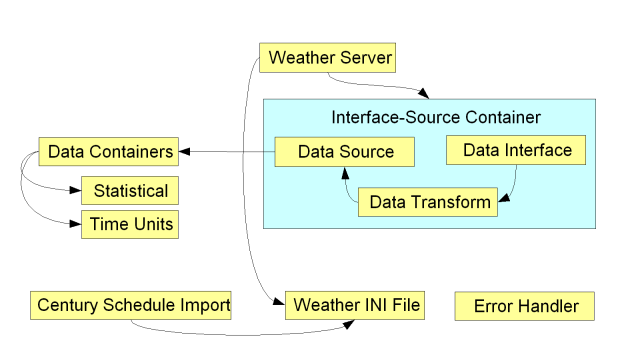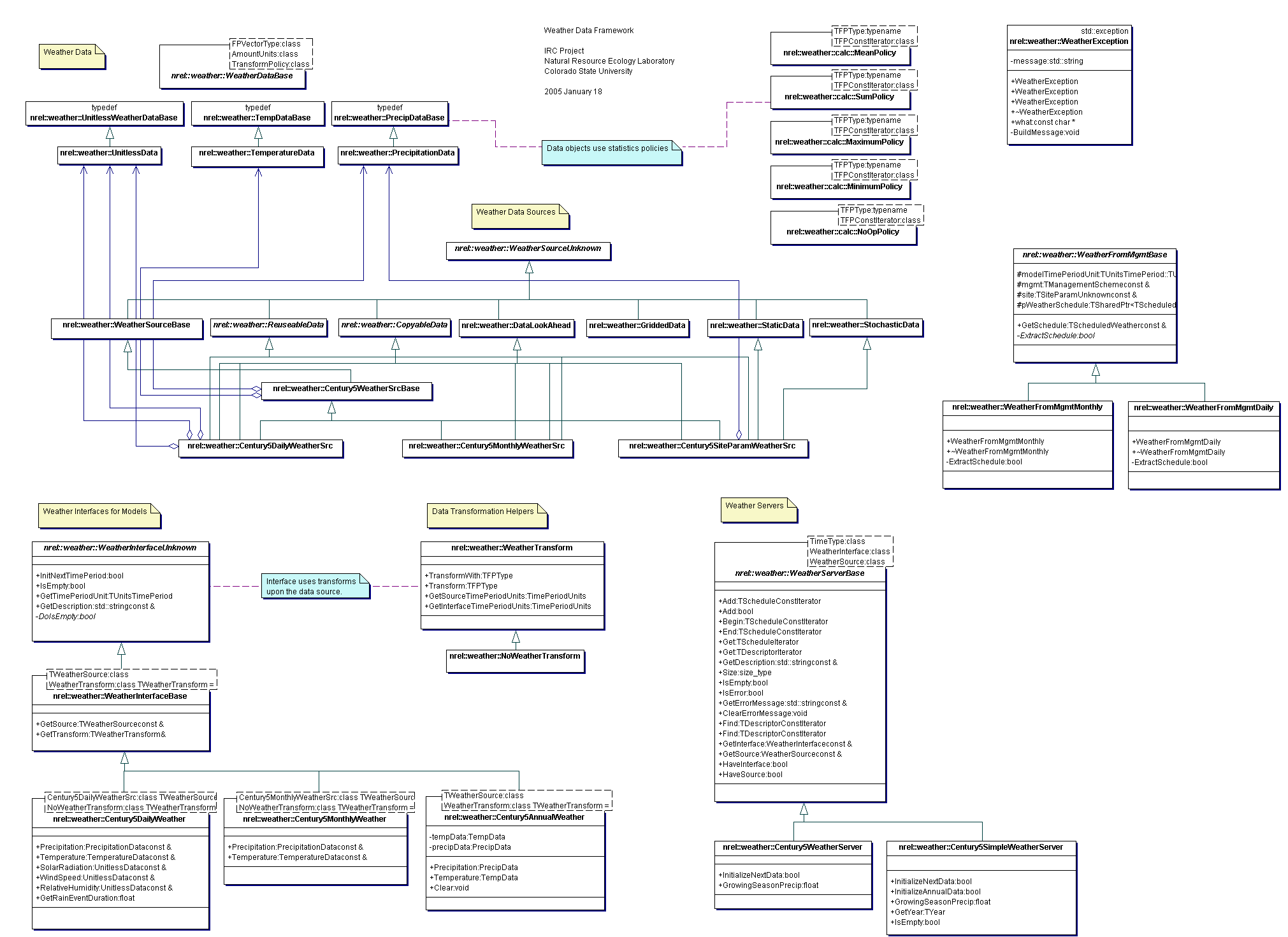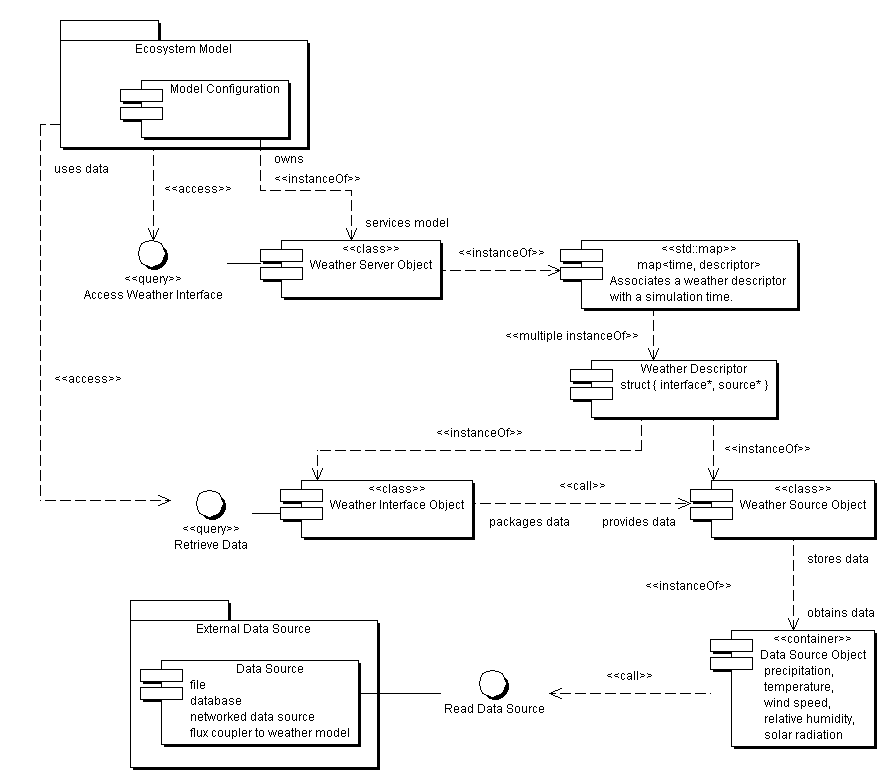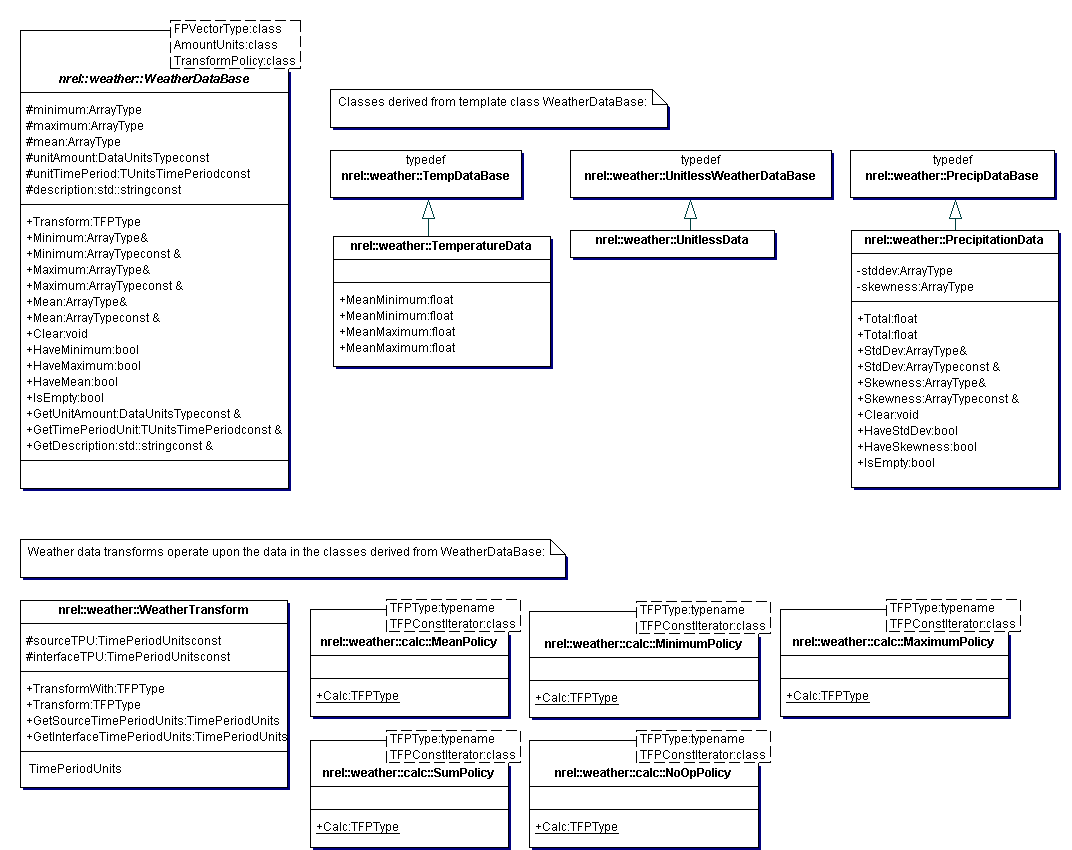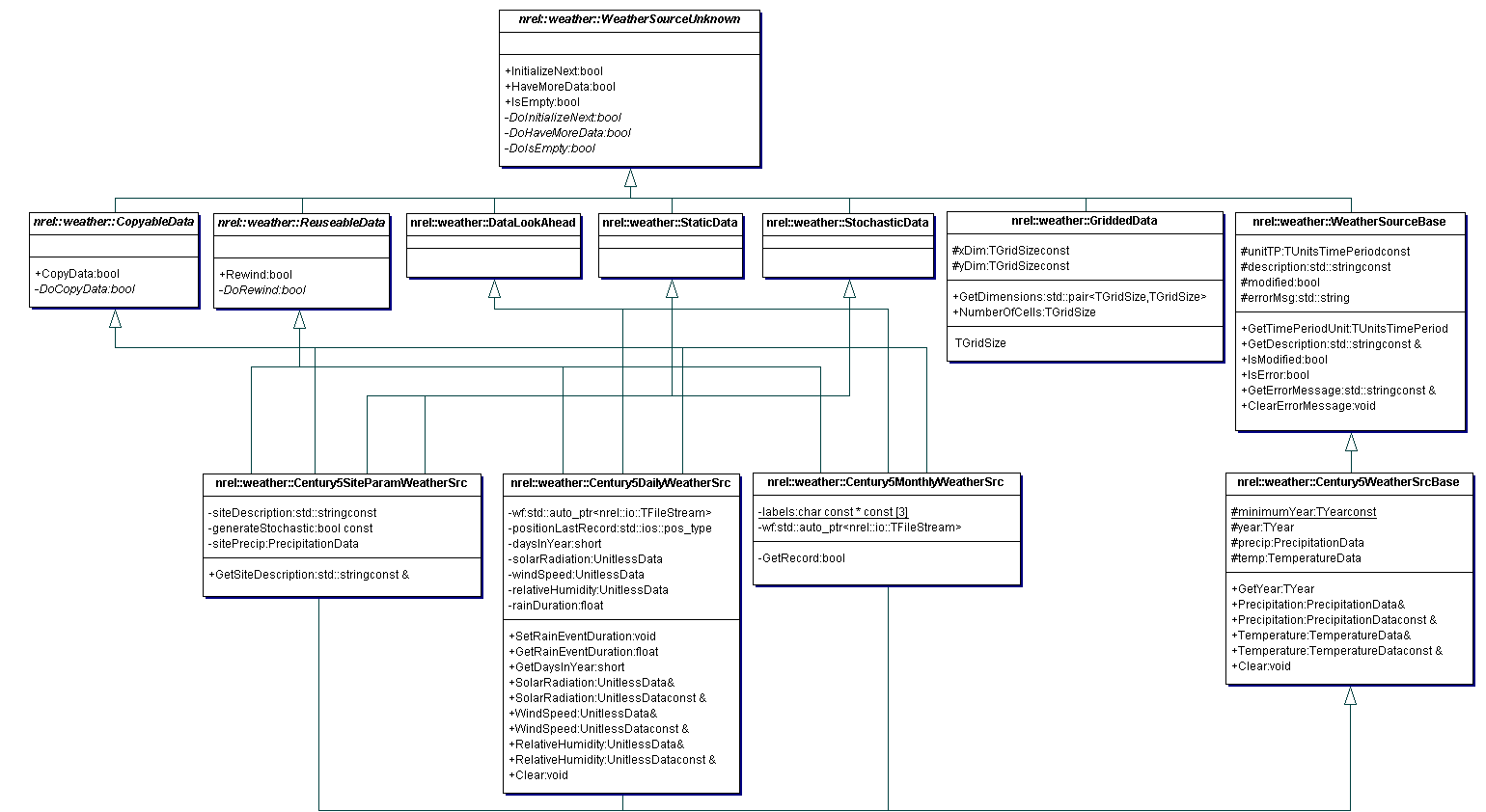Introduction
The Weather Data Framework is a collection of C++ class hierarchies for accessing
weather data. Major components of the framework include a data server which
has a collection of data sources associated with interfaces to the data.
The interfaces are used by a model or other software needing access to the
data. Each assocation of data source-interface is scheduled in simulation
time, that is, the data source-interface pair is made available when the
scheduled simulation time is reached. This allows the data sources to vary
throughout the course of a simulation.
The framework is designed to be extensible and flexible. It can be extended
with new data sources and new model interfaces.
The following diagram shows a functional view of the framework's subsystems.
A weather server has a container of linked data source-interface pairs. The
data sources store actual data in data containers. The weather server is
configured by a weather INI file, or from the object which owns it. A Century
monthly or daily weather source schedule can be imported from a Century management
schedule file, and the new schedule stored in a weather INI file.
Framework Architecture
Design Requirements
goals of the design
-
Separate the data source from the model. The model should not know or care
where the data originated, or its format. Provide an interface independent
of the format and origin of the data.
-
Specification of data sources to be separate from management (schedule
files). Century specifies weather in schedule files. Rather, specify
weather in separate configuration. Allow change of origin/type of data
during simulation.
-
Allow new data sources to be added later.
-
Allow new data interfaces to be added later.
Major Design Issues
Grid-Cohort Framework Issues
-
Data organization may be by: Data for one time at all cells (time-priority
simulations) Data for one cell at sequential times (space-priority simulations)
-
Request made by cell Algorithm needed to distribute weather data among
cohorts within cell
Century5 and DayCent5 Issues
-
Currently expects weather specified in management (schedule file)
-
Needs switch to ignore management weather
-
Century configuration should optionally supply weather object.
IRC Issues
-
Needs weather object to give to DayCent, so DayCent knows where to get
data.
-
Needs plug-in to GCF ClimateBase to handle all data requests (“Weather
Server”)
restrictions: compatibility
Weather Data Sources
-
Current and historical formats: Century 4, 4.5, 5 format: monthly text
file DayCent 4, 4.5, 5 format: daily text file Site parameters monthly
mean VEMAP daily NetCDF
-
New formats: Daily NetCDF COARDS-standard format
-
Anticipated formats: Data stream from RAMS or other weather models SQL
database retrieval
Current Weather Data Sources
|
|
|
Kind of Data
|
|
Time Period Units
|
|
Century4 Site Parameters
|
|
Precipitation: mean, std. dev., skewness
Temperature: minimum, maximum
|
|
monthly
|
|
Century 5 Site Parameters
|
|
Precipitation: mean, std. dev., skewness
Temperature: minimum, maximum
|
|
monthly
|
|
DayCent5 Site Parameters
|
|
Precipitation: mean, std. dev., skewness
Temperature: minimum, maximum
|
|
monthly
|
|
Century4.5 Site Parameters
|
|
|
|
|
|
DayCent4.5 Site Parameters
|
|
|
|
|
|
Century4/5 Weather File
|
|
Precipitation: mean
Temperature: minimum, maximum
|
|
monthly
|
|
DayCent4/5 Weather File
|
|
Precipitation: mean
Temperature: minimum, maximum
Solar radiation (optional)
Relative humidity (optional)
Wind speed (optional)
|
|
daily
|
|
NetCDF COARDS Daily File
|
|
Precipitation: mean
Temperature: minimum, maximum
Solar radiation (optional)
Relative humidity (optional)
Wind speed (optional)
|
|
daily
|
|
Class Hierarchy
describe; class UML diagram
describe component diagram
Weather Data Classes
Kinds of weather data derive from class WeatherDataBase (e.g., precip., temp.)
class WeatherDataBase, PrecipitationData, TemperatureData
Weather Source Classes
Kinds of data sources derive from class WeatherSourceBase (e.g., NetCDF)
Derived classes provide functions for reading and accessing the data. Is
paired with a weather interface object in the weather server object. Is
publicly accessed through weather server.
Behaviors: Data can be copied? Data can be reused? (“rewind” in
Century) Data has look-ahead (retrieve future data)? Data is static (constant)?
Characteristics: Time period resolution (monthly/daily/etc) Kind of data
(actual, modelled, stochastic, means, etc.)
Weather Interface Classes
Kinds of data interfaces derive from class WeatherInterfaceBase (e.g., daily,
monthly)
Knows its associated weather source object. Derived classes provide functions
for accessing the data. Is publicly accessed through weather server.
Weather Server Classes
Kinds of weather data servers derive from class WeatherServerBase (each server
is specific to an application)
Extracting Weather from Century Management
Classes that extract weather schedule from Century4 and Century5 management
schedules.
Implementation Requirements
Compilers, libraries
Using the Framework
The Weather INI File
Weather data is scheduled to be used in a simulation beginning at the start
of a specified simulation year. This schedule can be kept in a weather INI
file, according to the following format:
<simulation year>=<short description>,<time period of data>,<spatial domain>,<type>,<type-specific data>
The key name is the simulation year in which the weather source will begin
to be used. The fields assigned to the key are comma-delimited strings. An
example specifying daily Century weather files, would look like this:
1900=COARDS Daily Weather,day,file,coards-weather.nc
Types of data are:
|
Type name string
|
|
Type-specific data
|
|
file
|
|
File name, with path if needed. If the file name has the extension "nc",
it is assumed to be a NetCDF file. Otherwise, it is assumed to be a text-format
file, whose format is determined by the time period field.
|
|
site mean
|
|
Mean values from the site parameters.
|
|
site stochastic
|
|
Stochastic values calculated using values from the site parameters.
|
|
model
|
|
INI section name with the model-specific configuration information.
|
Time periods of data are:
|
Time period string
|
|
Description
|
|
hour
|
|
Each data value represents one hour. This option currently is not used.
|
|
day
|
|
Each data value represents one day. This is available in Century text-format
daily weather files, and in NetCDF COARDS-format binary files.
|
|
month
|
|
Each data value represents one month. This is available in Century text-format
monthly weather files.
|
Spatial domain types are:
|
Spatial Domain string
|
|
Description
|
|
site
|
|
Data applies to one site or point within a map or grid.
|
|
grid
|
|
Data is gridded; separate values are specified for each grid cell.
|
You can use comments to provide further description. Comment lines begin with
one of the following characters: # ! ;
The file name has the extension "ini" if it is in text format;
for example, "sim-weather.ini".
An example INI file is shown below:
[Description]
Description1=Weather for Colorado forest 6000-8500 elevation
Description2=Historical, Estes Park
DataSetName=
DataSetSource=
[EditorInfo]
EditorName=
EditorEmail=
EditorOrganization=
EditDate=
EditComment=
[Schedule]
1900=COARDS Daily Weather - Simulated,day,site,file,weather-estespark-historical.nc
1980=COARDS Daily Weather - Actual,day,site,file,weather-estespark-actual.nc
Specifying Weather in the Century5 and DayCent5 Models
Weather can be scheduled either through a Century5 management schedule, a Century4
schedule file, or a weather INI file.
Specifying Weather in the IRC Model
Text and tables here.
Weather Sources
Century
Model Weather Sources
The Century model, version 5, with a monthly time step, has the following weather
data sources:
-
site parameter monthly statistical precipitation and temperature;
-
monthly precipitation and temperature, either from the site parameters or
a weather file;
-
annual weather, derived from the monthly weather.
The daily version, DayCent5, also uses daily precipitation and temperature,
and optional data for solar radiation, relative humidity, and mean windspeed.
These are described further in the section Weather
Data Sources
and below under "DayCent4 and 5 Daily Weather Text File".
The model interfaces for the monthly Century are monthly precipitation and
temperature; annual precipitation and temperature. DayCent has daily precipitation,
temperature, solar radiation, relative humidity, and mean windspeed.
Century 4 and Century 5 Monthly Weather Data File
The weather data file is an ASCII (text) file containing rows of precipitation
and 2-meter temperature data. In the Century version 4, the columns must
be in a fixed format. In Century 5, this fixed column format is not required.
However, Century 5 does require the row/record organization described below.
Comment lines begin with one of the following characters:
# ! ; (Century5 only).
Missing values are represented in the weather data file by entering -99.99 into
the field where the missing data occurs.
If the weather data file contains weather data for a minimum of a ten year
period it can be used to generate precipitation means, standard deviations,
and skewness values, minimum temperature means and maximum temperature means.
These statistical values can be used to drive the stochastic weather generator.
You specify the statistical values in the site parameter set.
The weather data file name must be no more than 8 characters in length and
end with a “.wth” extension. The format of the weather
file is:
-
A four character name field. Valid entries for this field, shown in the required
order, are:
-
prec (precipitation)
-
tmin (2-meter minimum temperature)
-
tmax (2-meter maximum temperature)
-
Two spaces
-
A four character year field
-
12 number fields (one for each month) of the format 7.2 (The field is 7 characters
in length. 4 characters precede the decimal point, the decimal point is
counted as 1 character, and two characters follow the decimal point. Valid
characters that make up the numeric values are 0-9 and the minus sign (-).)
Precipitation values are entered in centimeters and temperature values
are in degrees Celsius.
The following is an example of two weather entries from a weather data file
formatted to be compatible for Century 4 as well as version 5:
prec 1915 0.31 2.55 5.07 7.01 8.87 5.13 1.61 8.83 3.55 3.53 0.99 0.92
tmin 1915 -13.50 -8.33 -8.17 0.78 1.67 7.00 9.72 8.33 5.39 -0.28 -6.06 -8.78
tmax 1915 4.44 8.56 4.33 16.33 17.50 21.06 26.83 26.06 22.89 18.89 10.78 8.50
prec 1916 1.57 0.31 0.37 1.68 8.07 2.90 4.27 2.84 1.06 2.64 2.06 3.06
tmin 1916 -16.50 -9.50 -4.89 -2.28 1.56 6.28 10.56 9.89 3.33 -2.44 -9.28 -14.78
tmax 1916 -0.61 8.67 14.22 14.33 20.28 25.44 32.39 27.28 24.56 14.78 8.78 1.56
DayCent4 and 5 Daily Weather Text File
The daily weather file in text format is arranged in columns, with each row
containing the data for one day. It is customary (but not required) for the
weather file name to have the extension "wth", as in mysite.wth for
instance. The columns for preciptation and temperature are required, but
the columns for solar radiation, relative humidity, and mean wind speed are
optional.
The following is an example of the daily weather file.
# day mon year doy temp max temp min precip solar rad rel humid wind spd
# --- --- ---- ---- -------- --------- --------- --------- --------- ---------
1 1 1910 1 1.1979 -19.8167 0.0000
2 1 1910 2 -6.6101 -17.1811 0.0000
3 1 1910 3 1.0010 -6.6729 0.0000
<snip>
30 1 1910 30 5.4748 -7.9216 0.0000
31 1 1910 31 10.3707 -5.3493 0.0000
1 2 1910 32 7.6402 -16.4190 0.0000
2 2 1910 33 5.9807 -9.5389 0.0000
<snip>
30 12 1910 364 10.2789 -11.9567 0.0000
31 12 1910 365 13.0964 -4.5152 0.0000
1 1 1911 1 11.9193 -7.3365 0.0000
2 1 1911 2 11.1026 -6.1654 0.0000
<snip>
The columns are: day of month, month number, year, day number in year, temperature
mininum and maximum, precipitation, solar radiation, relative humdity, and
wind speed. Comment lines begin with one of the following characters:
# ! ;
NetCDF COARDS-Format Weather Sources
<to do>
